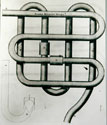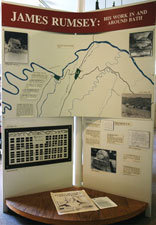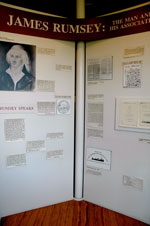Rumsey Exhibit – Manual
Panels 3 and 4 James Rumsey – Patents and Inventions
(Click on images to view enlargements )
Rumsey and his mill inventions: On the county map in the exhibit, five Rumsey mill sites are identified. It is possible that other mills built in the area during the late 18th century used Rumsey designs without his consent. Rumsey’s brother-in-law Joseph Barnes, in a 1792 pamphlet defending Rumsey’s right to benefit from his inventions (Treatise on the Justice, Policy and Utility of Establishing an Effectual System for Promoting the Progress of Useful Arts) hints that Rumsey’s neighbors “in the remote parts of the states” would steal Rumsey’s improved designs and feel no obligation to compensate him for his genius.
Rumsey was one of the first to attempt the application of scientific principles to the technology of mill machinery. He analyzed the efficiency of mill wheels and created methods and machines to improve this efficiency. Rumsey was highly successful in this attempt.
One of the significant activities of the Rumseian Society formed in 1788 (see exhibit and notes on Panel 6 in this manual) was to market Rumsey’s mill improvements. Brother-in-law Joseph Barnes contracted Rumsey mills for the Society, building many throughout the mid-Atlantic states. Several endorsements from pleased mill owners are housed at the American Philosophical Society Library including the following from David Binckley of Lancaster County, PA dated October 1790.
“…with very great pleasure we observed, that with the same quantity, or expense of water, with country stones, it ground as much wheat merchantably in 26 minutes as employed the water wheel, with burr stones, 64 minutes and we believe it may be further improved… (this mill was constructed)… upon the plan of Mr. Rumsey’s improvement of Dr. Barker’s mill.”
Rumsey mill patents:
-improvement on Savery’s machine: a steam engine whereby water may be raised in great quantities to any reasonable height for the turning of mills, or for agricultural or other purposes.
-improvement upon Dr. Barker’s mill: a mode to allow circular or retrograde motion mills with a smaller quantity of water to be moved or turned.
-cylendric saw mill: mode by which mill saws and other machinery requiring an alternating motion may be worked without loss of force of the water
These machines were patented by Rumsey in New York State and Delaware. They were also included in Rumsey’s 1788 pamphlet published for the American Philosophical Society, the pre-eminent scientific society in 18th century America.
Royal Patent #1673 – Nov 6, 1788 Rumsey patented several boilers for steam engines constructed on new principles. One of the uses for these improved boilers was “in giving motion to sugar mills, or to raise water, grind grain, or any other necessary purposes…”
Royal Patent #1738 – March 23, 1790 Rumsey patented a number of “new and improved methods of applying the power of water, of air, and of steam…to the purposes of milling…” The inventions include:
-a progressive and retrograde water-mill
-improvement of Dr. Barker’s mill
-retrograde machine for saw mills
-inverted steam engine for raising water
Royal Patent # 1825 –Aug. 25, 1791 Rumsey patented several applications of steam and water power to mills and machinery. There include several “new invented or improved” water wheels, a further improvement to Barker’s mill patented in 1790, application of steam to water wheels.
Royal Patent # 1903 – July 24, 1792 Rumsey patented “certain new methods of raising water…or applying their force to the purpose of milling…”
-water mill for grinding corn
In these Royal Patents, Rumsey demonstrated a high level of scientific ability in explaining the theoretical basis for his various inventions as well as demonstrating how various components of the inventions could be reassembled as different machines to serve varying purposes.
Copies of the Royal Patent specifications and drawings are included in the Museum’s Rumsey file. They were obtained from the British Museum: Keeper of Her Majesty’s Stationery, by the Rumseian Society of Shepherdstown.
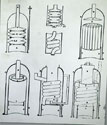 In 1791 Rumsey invented a mill “on entirely new principles” mentioning it in several letters of that period. This mill process is depicted in the exhibit graphic on the left: early water turbine. Check the Manual entry for that graphic for further information.
In 1791 Rumsey invented a mill “on entirely new principles” mentioning it in several letters of that period. This mill process is depicted in the exhibit graphic on the left: early water turbine. Check the Manual entry for that graphic for further information.
Rumsey’s primitive work conditions: In the 18th century Shenandoah Valley there were no handy machine shops with spare parts, trained mechanics, or easy sources of supply. Rumsey depended on his brother-in-law Joseph Barnes to construct his machines, Barnes’ writings, particularly a notebook housed at the American Philosophical Society archives in Philadelphia, demonstrate a skilled technologist and mechanic. A number of the key elements of Rumsey’s steam engines were made in Baltimore. The two-year delay before Rumsey made his first successful steam boat trial was due in great part to poor machinery. Even with his prototype boat complete and successfully tested, he still faced serious financial difficulties. England was attractive to Rumsey because there were both workshops where parts could easily be fabricated and people who were familiar with steam engines.
Rumsey’s lockless canal invention: William Bingham was a Philadelphia merchant and one of the important members of the Rumseian Sociey. In the letter Rumsey said: “that a machinery might be contrived, without the use of locks, to convey boats up or down between different levels of water either in perpendicular direction or on an inclined plane.” In this same letter, Rumsey suggests his plan for a floating dock patented in Royal Patent #1738 – 1790. This letter is housed at the American Philosophical Society Library in Philadelphia.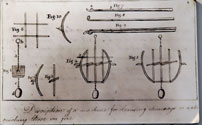
![]()
Chimney Cleaning Machine: This illustration was part of a submission to the American Philosophical Society made by Rumsey in 1786. The Society was the foremost scientific group in 18th century America. Rumsey’s submission also includes three pages of description. Although the document was not signed, the APS files include a May 2, 1788 letter from Rumsey asking for a copy of his plans for the chimney-cleaning machine.
Improved Water Tube Boiler Illustration: An improvement on the boiler invented by Rumsey in 1785 and also pictured in the exhibit. This improved boiler was patented by Rumsey in 1788 in Royal Patent #1673 and represents the scientific quality of his work after arriving in England. The figure illustrated was taken from a recent publication: Valleys of History.
Water Tube Boiler Illustration: In 1788 Rumsey submitted a pamphlet to the American Philosophical Society detailing several of his inventions including this new water tube boiler. Rumsey invented this in Bath in 1785 (See Manual note on Orrick’s Mill for Nicholas Orrick’s report on this invention.) The pamphlet was entitled: Explanation of Improvements in Mechanics and included several mill machines outlined on P6. of this Manual. The pamphlet is dated June 20, 1788.
Early Water Turbine Illustration: This illustration of Rumsey’s mill “on entirely new principles” was drawn by his brother-in-law and partner Joseph Barnes, in America, and sent in a letter to John Vaughn, a prominent Philadelphia businessman on September 21, 1792. Vaughn’s brother was interested in building this mill. Joseph Barnes, in his letter, states: “As a reward to the first adventurer in a distant state, and to encourage the introduction of a new and most efficacious Hydrautical Machine yet extant, I shall let your brother have a privilege to construct on Machine free of …premium.”
The essential new principle of this design is the movement of water through apertures in the hollow mill wheel itself. This principle, according to Dr. Edwin Layton, Professor of History of Science at the University of Minnesota, is the first necessary step to the design of water turbines – the giant machines that today generate electricity at large dams like Hoover and Grand Coulee. (Shown in Fig. 2 of the illustration). Barnes included in this letter pages of intricate calculations that would allow Charles Vaughn, in Connecticut, to have the mill constructed.
A copy of Barnes’ plans, obtained from the American Philosophical Society, is included in the Museum’s Rumsey file.
According to several letters, Rumsey invented this mill in the summer of 1791 after returning from a six-week job of overseeing construction of an Irish Canal. He states in his letters that he realizes this improvement will make his other mill designs obsolete.
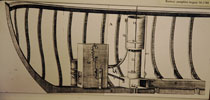 Boat Hull Illustration: This illustration is a plate taken from a Rumsey pamphlet: Explanation of a Steam Engine, dated August 30, 1788 and submitted to the American Philosophical Society. The illustration represents a picture of how Rumsey’s steam engine would be placed in a boat to provide the force to propel the boat against the current. The pamphlet is in the American Philosophical Society Library. The last page of the pamphlet is missing.
Boat Hull Illustration: This illustration is a plate taken from a Rumsey pamphlet: Explanation of a Steam Engine, dated August 30, 1788 and submitted to the American Philosophical Society. The illustration represents a picture of how Rumsey’s steam engine would be placed in a boat to provide the force to propel the boat against the current. The pamphlet is in the American Philosophical Society Library. The last page of the pamphlet is missing.
Panel 4 – Patents
Jefferson quote: Thomas Jefferson met James Rumsey in Paris while Jefferson was in his final months as Ambassador to France. They carried on communication about Rumsey’s inventions, particularly the steamboat. Jefferson assisted Rumsey in his contact with the French Academy of Science and his attempts to receive French patents. As an amateur scientist, Jefferson was intrigued by Rumsey’s work.
The letter from which this quote was taken was written to Dr. Joseph Willard of Harvard College. The context was that Jefferson was claiming to Willard: “In the arts, I think two of our countrymen have presented the most important inventions.” Jefferson names Thomas Paine and his invention of an iron bridge as one. “Mr. Rumsey has also obtained a patent for his navigation by the force of steam in England and is soliciting a similar one here. His principal merit is in the improvement of the boiler, and, instead of the complicated machinery of oars and paddles proposed by others, the substitution of so simple a thing as the reaction of a stream of water on his vessel. He is building a sea-vessel at this time in England and she will be ready for experiment in May. He has suggested a great number of mechanical improvements in a variety of branches; and upon the whole is the most original and the greatest mechanical genius I have ever seen.”
This letter is contained in the Jefferson Papers in the Manuscript Room of the Library of Congress.
 Pole Boat Demonstration and Washington’s Certificate-Prior to the establishment of the U.S. Constitution in 1789, inventors seeking to protect their inventions and gain exclusive rights had to apply individually to each state. Certificates from prominent people aided such applications. At this time in history, General George Washington was the most prominent man in America. Washington owned great amounts of land along the then western boundaries of the United States and was interested in opening up this area through inland navigation. He was, therefore, immediately attracted to Rumsey’s claims of a mechanism that would move boats upstream against the current.
Pole Boat Demonstration and Washington’s Certificate-Prior to the establishment of the U.S. Constitution in 1789, inventors seeking to protect their inventions and gain exclusive rights had to apply individually to each state. Certificates from prominent people aided such applications. At this time in history, General George Washington was the most prominent man in America. Washington owned great amounts of land along the then western boundaries of the United States and was interested in opening up this area through inland navigation. He was, therefore, immediately attracted to Rumsey’s claims of a mechanism that would move boats upstream against the current.
Satisfied with the demonstration of Rumsey’s model (see Manual notes P4 for more information on the boat) Washington issued Rumsey a certificate endorsing Rumsey’s invention. It was Rumsey’s first boost onto the stage of history and marked the beginning of Rumsey as a public man. He widely publicized the Washington certificate in period newspapers, and in his petitions to state legislatures seeking patents. Rumsey also submitted Washington’s certificate to the Continental Congress with his request for land in return for constructing his boat.
 The copy of Washington’s certificate shown here is from Washington’s Letter Book – a collection of volumes wherein Washington had his secretary enter a copy of every piece of correspondence. The original Letter Books are housed in the Manuscript Room of the Library of Congress. According to W.W. Abbott, Director of the Washington Papers Project at the University of Virginia, there is no known surviving copy of this certificate in Washington’s own hand.
The copy of Washington’s certificate shown here is from Washington’s Letter Book – a collection of volumes wherein Washington had his secretary enter a copy of every piece of correspondence. The original Letter Books are housed in the Manuscript Room of the Library of Congress. According to W.W. Abbott, Director of the Washington Papers Project at the University of Virginia, there is no known surviving copy of this certificate in Washington’s own hand.
The certificate was written and dated the day after the actual demonstration, which occurred in Bath.
Rumsey’s Virginia Patent: Rumsey received patents for his mechanical boat from the Virginia House of Burgesses in October and the Maryland Legislature in November of 1784. Washington’s influence was instrumental in his obtaining the Virginia patent. Both granted Rumsey exclusive rights to his navigation principles for 10 years. Neither granted him any money.
In a letter to fellow legislator James Monroe, John Marshall praised the Rumsey patent saying “The exclusive privilege given to Rumsey and his assigns to build and navigate his new invented boats is of as much, perhaps more consequence than any other bill we have passed.” Dec 2, 1784
Rumsey petitions to Delaware and Pennsylvania were caught up in controversy with Fitch and in the passage of the U.S. Constitution. In 1788 Rumsey received patents from New Jersey and New York, both of which included his steam engine and mill machines and did not mention the mechanical boat.
To aid in the expensive search for state patents, Rumsey enlisted the financial help of a partner. On November 10, 1784 Rumsey signed an agreement with Dr. James McMechen for the purpose of obtaining exclusive rights from the states for Rumsey’s inventions. All petitions were to be in Rumsey’s name; McMechen would receive a percentage of the profits, the rest to Rumsey. After his death, Rumsey’s estate was sued by McMechen seeking the profits due him from Rumsey’s ventures. The papers from the McMechen case are included in the Museum’s Rumsey file.
Copies of Rumsey’s Law in Virginia and in Maryland are included in the John Fitch Papers, Peter Force Collection, Library of Congress.
Rumsey and John Fitch: Beginning as early as 1785, Rumsey became involved in a controversy with John Fitch who also claimed that he had invented the first steamboat. The controversy included visits by Fitch to George Washington who warned Rumsey to move quickly on his boat. Fitch worked in the Philadelphia area and allegedly demonstrated his boat on the Delaware. (The Smithsonian Institute in Washington honors Fitch’s claim.)
Once Rumsey was able to successfully demonstrate his steamboat in December 1787 at Shepherdstown, he moved quickly to publicize his claim with his first pamphlet: A Plan Wherein the Power of Steam is Fully Shewn, Jan 2, 1788. In this pamphlet Rumsey recites the history of his work on navigation beginning with his boat demonstration to Washington in 1784. He directly challenges Fitch’s work claiming that his machinery was too big and heavy. The pamphlet contains a series of depositions from Rumsey supporters about dates and events related to the steamboat. In this pamphlet, Rumsey’s brothers-in-law Charles Morrow and Joseph Barnes claim that a Mr. Cruse came to visit Rumsey’s workshop in Shepherdstown and carried off Rumsey’s ideas. Rumsey also mentions his mill machines in this pamphlet.
When John Fitch gets hold of the pamphlet he writes one of his own entitled: The Original Steamboat Supported: May 10, 1788 in which he attacks Rumsey as a liar and includes a number of depositions of his own aimed at discrediting Rumsey. In addition, Fitch includes a reprint of Rumsey’s pamphlet in his own. It is in this pamphlet by Fitch that the only mention of Rumsey being involved with bathhouses at the springs at Bath is made; Fitch claims that some cocks Rumsey had made for the steamboat were alleged to be for the springs bathhouse.
Rumsey was in Philadelphia seeking help and support from the American Philosophical Society when Fitch’s pamphlet appeared. Rumsey immediately reprinted his January pamphlet under the new title: A Short Treatise on the Application of Steam, dated May 7, 1788. The pamphlet was the same as the January one except for excluding the Morrow and Barnes accusations against Cruse and including a letter from Washington.
Englehart Cruse wrote his own pamphlet: The Projector Detected in 1788 attacking Rumsey and defending himself. Cruse mocks Rumsey for taking so long to perfect his steamboat “unfortunately the workmen were such bunglers that you were obliged for the present to lay aside this capital invention.”
Upon leaving for England in the midst of this controversy, Rumsey begged Barnes and Morrow to continue to defend his inventions against Fitch. Barnes published his own pamphlet: Remarks on John Fitch’s Reply to James Rumsey – July 7, 1788, reiterating Rumsey’s claims and including more depositions to support their case.
The need to get credible support with patents in Europe was a main motive for Rumsey’s trip in May 1788. Examination of Fitch’s papers in the Library of Congress show a few sketches for other steam mechanisms including a steam cannon, but there is little evidence that Fitch was truly an inventor. Certainly not one that could compare to Rumsey with his more than 30 patents.
During the 18th and 19th centuries, before the advent of a widely read press and magazines, pamphlets and broadsides were the most important means of public communication.
All the pamphlets cited above are included in the Rare Books Collection of the Library of Congress. A 19th century reprint of Rumsey’s Short Treaties on Steam pamphlet is part of this site.
Rumsey and the Patent Law: Like Washington and Madison and Franklin, Rumsey supported a strong, national constitution because of its economic benefits. Rumsey was interested in a national Patent Law that would save inventors from applying to a dozen states with varying rules and levels of protection. Rumsey suffered under the patent system of the Continental Congress. Rumsey and his supporters lobbied for a strong Patent Law under the Constitution.
On June 6, 1789, Rumsey wrote Jefferson in Paris about arrival of the news of the organization of the Federal Government on April 23, 1789. Rumsey then writes extensively about his problems with Fitch, with the New York Legislature, and his desire for strong system of exclusive rights. Rumsey asks Jefferson to intercede for him “knowing you could throw great light upon the subject upon your return to America. In an exchange of letters from Miers Fisher and Robert Barclay, both Rumseian Sociey members, Fisher talks about the obstacles he encountered during the past year trying to get Rumsey patents. He then relates how in drafting the Patent Law bill he avoided provisions of the English Law regarding experiments which had injured Rumsey in state dealings:…”in our bill, the originality of the invention is sufficient when proved to entitle the inventor to a patent however public the thing may be…this will effectively secure Rumsey.” April 5, 1790. This letter is available at the American Philosophical Society Library in Philadelphia.
The letter illustrated in the exhibit was written by Rumsey to the Rumseian Society and Levi Hollingsworth. The rest of the letter complains about Rumsey’s financial problems in London because of the untrustworthiness of a Society member in England, Wykoop. This letter is copied from the American Philosophical Society Library.
In 1792, Joseph Barnes published a long, scholarly pamphlet defending Rumsey’s patent rights and expounding on the principles that should be included in a just Patent Law. The pamphlet was aptly titled: “Treatise on the Justice, Policy, and Utility of Establishing an Effectual System for Promoting the Progress of Useful Arts, by Assuring Property in the Products of Genius.”
Barnes wrote a classic 18th century text laying out the philosophical basis for his argument claiming that not rewarding genius as property would “confine improvements to the opulent class of men, among whom real genius seldom appears.” He also cites historical references. Barnes goes on to outline deficiencies in the House committee bill for a Patent Law reported in October 1791. Barnes then specifically defends Rumsey saying that he finds himself in the unhappy predicament of people stealing his patent; a predicament which can be resolved only by an effectual system.
Barnes then lists his principles for a just system. Many are mentioned in Rumsey’s 1789 letter to Jefferson described above. Barnes however is erudite in his recital. One of the key provisions stated by Barnes was that to use either the original invention or an improvement of it required permission of the inventor.
This pamphlet is housed in the Rare Books Room of the Library of Congress.
First-day Patents: Although Rumsey was disappointed with provisions of the Patent Law passed by the Congress under the new U.S. Constitution, he submitted his steam navigation plans for consideration. So did his rivals. After months of delay, it was finally decided to award Rumsey and his rivals John Stephens Jr. and John Fitch patents for their respective steam propulsion methods. They were the first to receive U.S. patents on August 26, 1791.
A fire in the Patent Office in Washington in 1835 destroyed all early patent records. Only a few have been reconstructed, Rumsey’s were not. Patent Office records show that Rumsey received a total of six U. S. Patents probably for his steam engine and mill machines patented elsewhere as well as his process of steam navigation.
Rumsey proponents have accused the first Patent Officer: Dr. William Thornton, of being a Fitch proponent, and thus discriminating against Rumsey.
J.L. Bishop in his History of American Manufactures list Rumsey’s first-day patens as: Savery steam engine, improvement on mills, hydrostatic bellows, generation of steam, and propulsion of boats.
Included in the John Fitch Papers at the Library of Congress is a note to Fitch from Henry Remsenjun, Clerk dated Philadelphia, November 23, 1790: “Some of the claims for patents founded on the supposed discovery of new applications of steam to useful purposes, not having been stated so precisely as to be satisfactory to the Board, and it being their wish to hear all those claims together.
Ordered, that the 1st Monday of February next be appointed for the hearing of all the parties interested; that notice be given to John Fitch, James Rumsey, Nathan Read, Isaac Briggs, and John Stevens of this order; and that each of them be required to transmit in writing to the Board a precise statement of their several inventions, and of the extent thereof.”
First Successful Boat Trial: The December 3, 1787 boat trail in Shepherdstown was the first successful steamboat trial made in public. Rumsey had made several trials prior to this and one more in America after it. A chronology of boat trials is listed below.
The December 3 boat trial was a major event in Shepherdstown witnessed by many including the area’s leading citizen General Horatio Gates who is reported to have exclaimed “My God it moves.” Sworn statements of several who witnessed the trial are included in Rumsey and Barnes pamphlets.
According to a number of accounts, the demonstration began at noon before hundreds of spectators along the cliffs of the Potomac. A number of ladies joined Rumsey, Morrow and McMechen aboard the boat. For two hours the boat steamed up and down the river from Swearingen’s Spring at Bellevue to the present site of the Rumsey Monument.
The boat was reportedly about fifty feet long, with a three ton loading, and was propelled by steam alone at the rate of three miles per hour. A vertical pump, operated by steam, drew the water in at the bow and expelled it at the stern through a horizontal trunk at the bottom — a reaction-propulsion technique
Steamboat chronology:
1783 – Rumsey claims the idea of propelling a boat by steam first came to him.
November 10, 1784 – agreement with Dr. James McMechen to finance search for boat patens. Steam not mentioned specifically.
March 3, 1785 – in letter to Washington, Rumsey mentions boat of new type (steam)
May 1785 – Continental Congress grants Rumsey 30,000 acres of Ohio land if he can build boat in a year. Rumsey hires brother-in-law Joseph Barnes to construct boat at mouth of Sir Johns Run near Bath. (see Morgan County map in exhibit for location)
December 1785 – Barnes and McMechen float boat with machinery on board downriver to Shepherdstown.
January 7, 1786 – ice stopped work on boat. Boat was put in mouth of run and machinery in Francis Hamilton’s cellar. During this period, Rumsey invented new style steam boiler (see exhibit for water tube boiler illustration and P8 of Manual for more information.)
March 14, 1786 – Using the old boiler Barnes, Morrow, McMechen and Hamilton took boat out for trial run. It was successful but boiler came apart.
Spring 1786 – another failed trial.
September 9, 1786 – Rumsey made a trial on the river of a pole boat, based on the model he demonstrated to Washington at Bath in 1784 (see P4 in Manual for more information). This full size boat had only one boat instead of two linked together as with the 1784 model. There were problems in the trial. In a September 19, 1786 letter to Washington, Rumsey described the boat trial. After this, Rumsey seems to abandon the pole boat although it is included in his 1790 Royal Patent (see illustration of pole boat in exhibit and information on P15 of Manual). This boat did not use steam.
December 1786 – a boat trial was held using Rumsey’s new boiler. It melted the solder used. Then ice carried off the boat and destroyed it.
July 1787 – Repaired boat and boiler by this time.
September 1787 – successful trial on river but poorly built boiler allowed steam to escape.
December 3, 1787 – first successful public boat trial (see details P13 Manual) at Shepherdstown.
December 14, 1787 – another, and final American successful trial at Shepherdstown. Boat speed increased to 4mph.
May 1788 – Rumsey went to England and remained until his death in 1792. He worked on boat as finances allowed.
February 1793 – Rumsey’s Columbia Maid steamboat had first successful trial in London reaching a speed of 4 knots per hour.
All the dates listed above are taken from period documents; most from the three pamphlets written by Rumsey, John Fitch, and Joseph Barnes in 1788. These pamphlets are available in the Rare Books Collection of the Library of Congress. A copy of Rumsey’s pamphlet is available online. (See P20 of Manual for more information.)
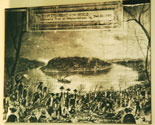 Boat Demonstration – John Moray, a local historian and artist around the turn of the 19th century, became a Rumsey enthusiast. He made sketches of several area locations and events involving Rumsey including Rumsey’s first successful steamboat trial in Shepherdstown on December 3, 1787. This sketch was made in 1907. Moray then photographed his sketch with glass negatives from which this print was made. The glass negatives were given from Fred Newbraugh’s private collection to the Regional Collection of West Virginia University Library. Moray created the sketch from local accounts of the event. (see entry above for details of boat trial.)
Boat Demonstration – John Moray, a local historian and artist around the turn of the 19th century, became a Rumsey enthusiast. He made sketches of several area locations and events involving Rumsey including Rumsey’s first successful steamboat trial in Shepherdstown on December 3, 1787. This sketch was made in 1907. Moray then photographed his sketch with glass negatives from which this print was made. The glass negatives were given from Fred Newbraugh’s private collection to the Regional Collection of West Virginia University Library. Moray created the sketch from local accounts of the event. (see entry above for details of boat trial.)
Rumsey’s contributions to steam engineering include:
- improved boiler: zig zag pipes provided economy of space, high efficiency, and the ability to handle high pressure. This design is the basis for the steam boilers used today to power ocean liners and giant electrical plants.
- heating of boiler feed water
- use of two fluids of different boiling points in heat process. This hints of advanced mercury-steam boiler.
- use of steam for heat after it has been used to generate power.
- facilitating evaporation by application of a partial vacuum.
- key principles for applying steam power to propulsion of vessels including reaction force. Rumsey was one of the first to use Newton’s Third Law in practical engineering.
- Principles for applying steam power to mills and machinery through systems of rods, pistons, and rotary motion.
Rumsey’s American patents were primarily mechanical inventions, products of a technologist. Rumsey’s British patents showed the development of Rumsey the scientist, with scientific principles applied to improve his early inventions.
The specifications and drawings for Rumsey’s four British patents are available for study from the Museum’s Rumsey file.
 Progressive and retrograde water mill from Royal Patent #1738 – 1790. See excerpt from patent specifications on following page.
Progressive and retrograde water mill from Royal Patent #1738 – 1790. See excerpt from patent specifications on following page.
Inverted steam engine from Royal patent #1738 – 1790. Used for moving vessels at sea, for moving a pole boat in shallow water, moving carriages and wagons by means of ratch and pinion wheels.
Rumsey’s horseless carriage. In the specifications for Royal patent #1738 in 1790 Rumsey describes how his inverted steam engine (see drawing in exhibit) may be used to move carriages with either poles (like his pole boat) or ratch and pinion wheels fixed on an axis. Poles would be used only when the wheels get into gullies or going up hill put into action with a lever. Rumsey says “in cities and towns it may be necessary to use a horse to steer such carriages but on the road it may be done with ease by mechanism of various kinds.”
Pole Boat: In Royal Patent #1738 – 1790 Rumsey patented an improved model of his pole boat which he originally showed Washington in 1784 in Bath. (See P4 Manual for details of this original boat.) Rumsey adapted the original pole boat design in this patent for use with a steam engine. The pole boat was designed for shallow, fast moving rivers. See excerpts from patent specifications on following page.
click on image to view each section of manual
|
Panels 1 and 2 |
Panels 5 and 6 |
|
Rumsey’s Work In and Around Bath |
The Man and His Associates |

